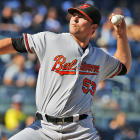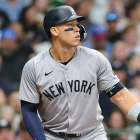SARASOTA, Fla. -- The Baltimore Orioles have won more games than any other American League team over the past five years. But they’ve also failed to win a single post-ALDS game in that span. The way in which Baltimore bowed out of last year’s playoffs was so painful, and so inexplicable, it became a meme.
As much as playoff disappointment can sting, the O’s regular-season success feels like a small miracle, given how much computers seem to hate them. Despite winning 93, 85, 96, 81 and 89 games the past five seasons, the statistically based advanced projection systems spit on Baltimore every year. Take a composite of the Baseball Prospectus (PECOTA), Fangraphs and ZiPS forecasts, and you get an aggregate prediction of 77 wins in 2017. SportsLine is projecting them for 82.4 wins. That despite the Orioles bringing back almost exactly the same roster as the club that tied for the seventh-most wins in all of baseball last season.
No one is more tickled by that disconnect than Buck Showalter.
“PECOTA said the last five years, ‘You guys can believe us on 29 clubs, but we haven’t figured out the Orioles,’” the O’s skipper said. “Once again, kind of fun for our players to make people scratch their heads with our team.”
The Orioles’ gaudy five-year record and three playoff appearances in that span, as well as their ability to smash projections, can be traced to their consistently excellent bullpen.
Relief pitchers tend to be extraordinary volatile, for multiple reasons. First, a pitcher whose entire season might include 60 innings can see his results vary wildly; a reliever who merely slumps for two days and gives up three-run homers both times has gone a long way toward crushing his numbers for the whole season. Second, relievers, like all pitchers, are injury-prone, with the added risk of sometimes getting tapped to throw three days in a row with aching arms to satisfy the needs of impulsive managers. Third, relief pitchers are often failed starters who lacked the health, stamina or basic ability to neutralize hitters for seven or eight innings at a time, meaning they might not be all that good, thus making them susceptible to getting lit up. Projection systems bake that volatility into their calculus, predicting that a team’s terrific bullpen one year will regress toward the mean the next.
That regression never shows up when you’re the Orioles ... or at least it hasn’t in the past half-decade. The O’s bullpen, like every other team’s pen, employs a squad of pitchers who couldn’t (or wouldn’t) cut it as starters. Their elder statesman is a sidearmer, and no starter in recent memory (other than perhaps oft-injured right-hander Justin Masterson) has stuck around for long with anything close to that delivery. Last year’s primary setup man was a 42nd-round pick. And their closer is a former starter who couldn’t hack it in the rotation and only found success once he moved to the bullpen and junked all but one of his pitches.
Despite those modest backgrounds, Darren O’Day, Brad Brach and Zach Britton have helped the O’s build a nearly impenetrable bullpen during the team’s five-year run of success. The now-34-year-old submariner O’Day was one of the stingiest relievers in baseball from 2012 through ‘15, posting a strikeout-to-walk rate of around 5-to-1 and stranding runners at astronomical rates despite wielding a fastball that hovered around 88 mph. When O’Day faltered last season, Brach stepped into the breach, ranking at or near the top of the league among relief pitchers for appearances (71), innings pitched (79) and strikeouts (92).
Then there’s Britton. Not since Mariano Rivera has any pitcher found one pitch that so thoroughly flummoxed opposing hitters. In Britton’s case, it’s his deadly sinker, a bowling ball of an offering delivered at 97 mph. In 2016, opponents batted a lowly .157 against that sinker; they slugged a microscopic .193 against it. Those struggles had nothing to do with deception either. Just as Rivera’s infamous and terrifying cutter was more or less the only pitch he threw, Britton mostly eschews other offerings to fire the sinker; he leaned on that pitch 92 percent of the time last season.

Throw in 26-year-old fireballer Mychal Givens, and the O’s once again stymied opponents late in games last year, going 21-16 in one-run contests and 6-2 in extra innings. The Orioles probably won’t ever again replicate their off-the-charts results in 2012, when the team went a record-breaking 29-9 in one-run games and 16-2(!) in extras. But Baltimore might represent a case of general baseball rules not applying in one specific case. If a team can build a bullpen that thrives every year, it could put itself in position to win a disproportionate number of close games -- defying the sabermetric wisdom which holds that such results stem from luck, and aren’t likely to keep happening for long.
The Orioles, led by a general manager in Dan Duquette with a knack for nabbing under-the-radar talent like Brach for next to nothing and a manager like Showalter who (last year’s wild-card game notwithstanding) has shown a knack for pushing the right buttons at the right time, might be that rare outlier.
“We pass the load around, to physically help them with the ups, the downs, the things that really challenge bullpens,” said Showalter. Those efforts to keep everyone fresh include avoiding the use of his best relievers in lower-leverage situations as much as possible. Last year, longman Vance Worley soaked up valuable innings that helped keep Brach, Givens, and Britton fresh. “That’s one of the things we’re down here trying to find” in spring training, Showalter added. “Somebody who can do that job again.”
With apologies to potential fourth-inning mop-up men, the bigger predictor of any 2017 Orioles success will likely be the team’s starters ... the pitchers who might actually force Showalter’s hand in the fourth inning of games. Last season, O’s relievers led the AL in park-adjusted ERA, while the team’s starters ranked fourth-worst in the junior circuit by that metric.
The hope this year is that Baltimore’s two former first-round draft picks can lead the way for a rotation that’s been shaky for most of this five-year run. Kevin Gausman, the fourth overall pick in the 2012 draft, chopped his second-half ERA by more than a run after last year’s All-Star break, and could be poised for a breakout if he can chop his perennially high home-run rate. Dylan Bundy, the fourth overall pick in the 2011 draft, struggled with both long balls and walks last year, and looks less refined at this point of his career. With de facto ace Chris Tillman in danger of starting the season on the disabled list with a shoulder ailment, and the highly volatile combination of Ubaldo Jimenez and Wade Miley ticketed for the other two spots in the rotation, a dual emergence by Gausman and Bundy couldn’t come at a better time.
Duquette identified another point of emphasis for the 2017 O’s: outfield defense. According to Baseball Info Solutions’ Defensive Runs Saved, the Orioles trotted out the worst outfield defense in all of baseball last year, allowing 51 more runs than league average. Adam Jones will continue to play every day in center, so the Orioles will have to deal with his glove, rated among the worst in baseball at that position despite a rosier reputation. The hope is that newly-acquired walks hound Seth Smith can be a steady if unspectacular defensive upgrade over 2016 AL home-run king Mark Trumbo in right (Trumbo figures to DH this year). Left field, though, remains anyone’s guess: Hyun Soo Kim rated terribly with the glove last year, so Duquette performed his usual round of dollar-store shopping, hoping to find some flycatchers in a pile that includes veterans Craig Gentry and Michael Bourn.
The team that led the majors in homers by a wide margin last year figures to score a lot this year too. That makes run prevention the likely X-factor when it comes to the Orioles’ hopes for smashing PECOTA and making another playoff run. If the rotation and outfield D can be anything close to respectable, the bullpen from hell could be powerful enough to do what it’s done so well for so long: defy the odds, and make everyone wonder how much longer all of this can last.






















